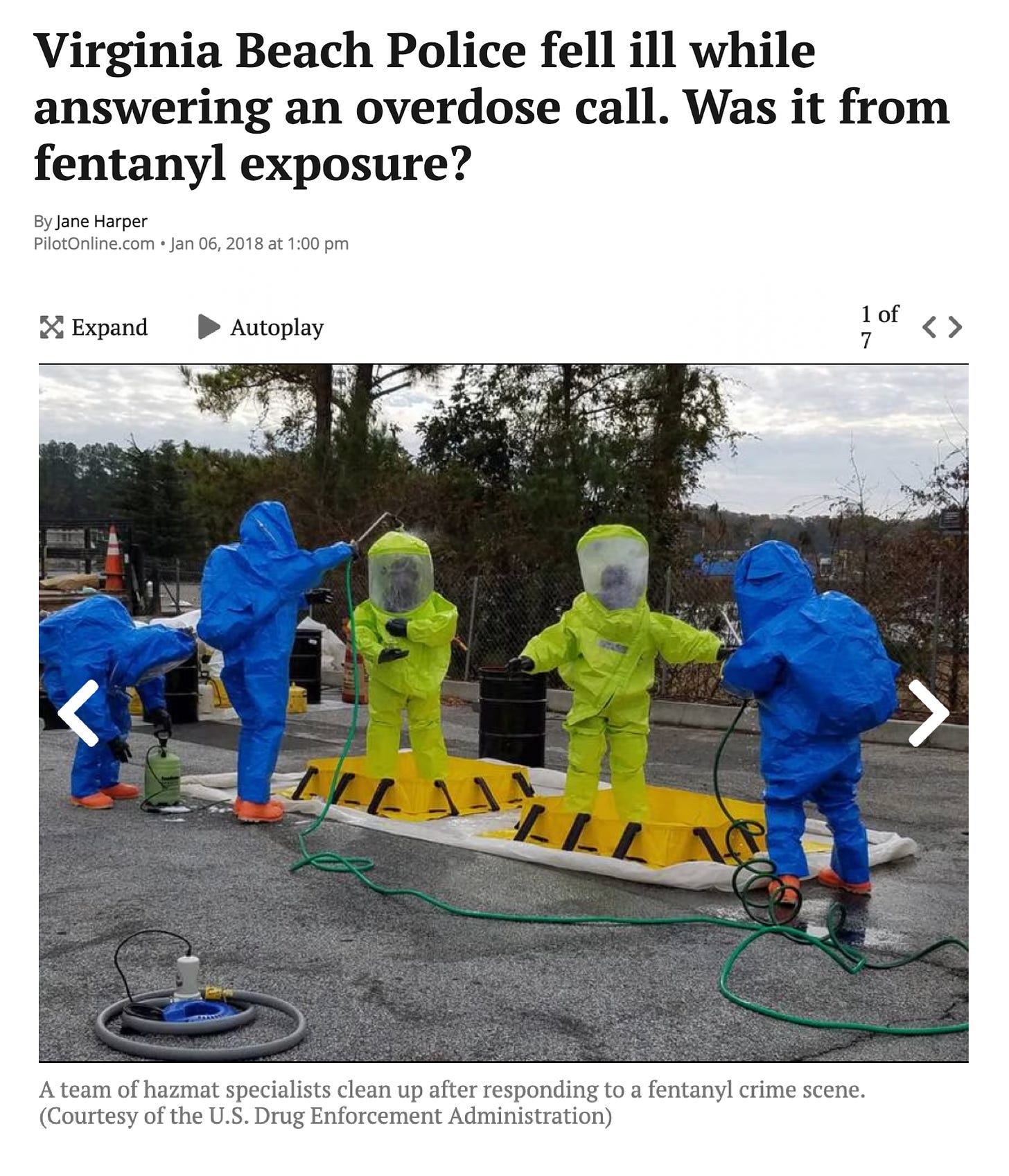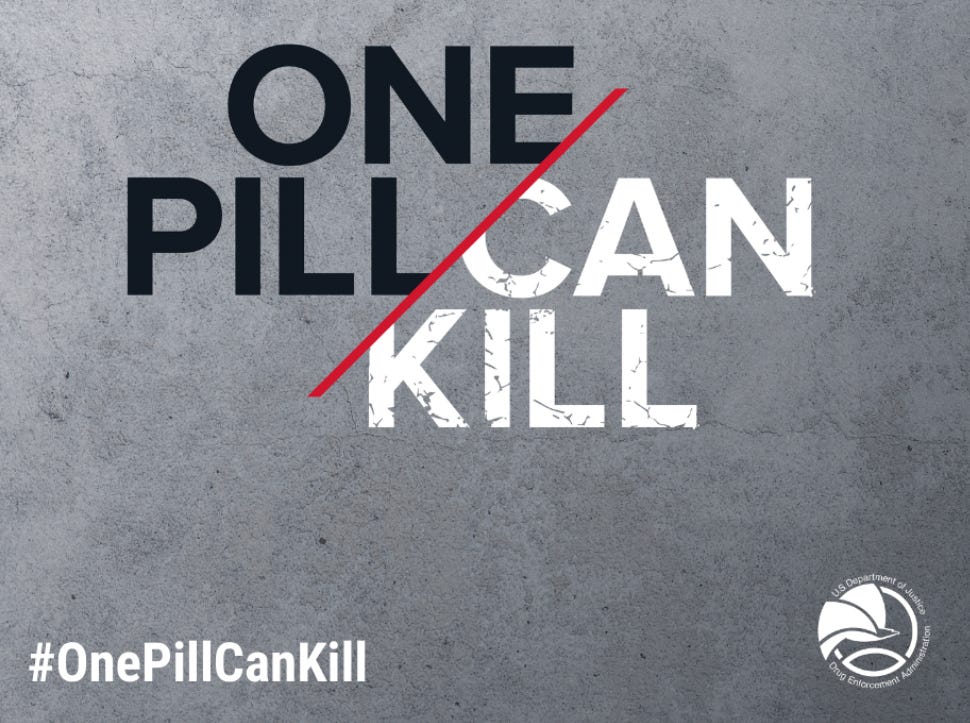Content warning: discussion of fentanyl use and OD.
A few months ago my plug said he was hesitant to continue selling fentanyl. He called it “public enemy number one.” Within a month, he was arrested in a multi-agency raid. This isn’t the first time that’s happened. Each time I’m reminded that the cops care only about making arrests, not about what will happen to people like me.
This is the result of fentanyl sensationalism: widespread media outcry about the dangers of fentanyl, justifying punitive responses to possession and distribution. It’s true that overdose rates are skyrocketing, and fentanyl sensationalists appeal to that data to justify their position.
From Statista. See also Santa Monica Daily Press.
However, the massive, systemic circulation of misinformation is not conducive to saving lives. Quite the contrary, actually: the fentanyl panic kills, incarcerates, and marginalizes.
Overdosing on Fear
Cops’ headline-dominating theatrics about the dangers of fentanyl are a simple example of this insidious narrative. In the past few years, there has been a media trend of viral stories of police fentanyl overdoses from touching or inhaling negligible quantities.
The symptoms of a true opioid overdose are quite literally the opposite of the reported symptoms in such stories: slowed breathing and loss of consciousness. The person wouldn’t be able to shout for Narcan—they’d be unconscious or close to it. Meanwhile, a panic attack is characterized by rapid breathing, shaking, and dizziness. (Rapid breathing in particular is completely uncharacteristic of opioid ODs.) Many argue that these “touch overdoses” are actually panic attacks: created by subconscious fears that self-reinforce as the mass hysteria around fentanyl increases.
“Something as simple as the wind could expose you and just like that, your life could end.” -Officer Courtney Sullivan, Tavares Police Department
The pervasive myth that touching or even being near fentanyl can cause a reaction is completely and utterly false. No, it’s not “super fentanyl*” or perfectly timed gusts of wind. Media outlets devour and regurgitate what is essentially police propaganda, without making any effort to investigate potentially misleading or false claims.
It is irresponsible reporting to groundlessly claim that a cop overdosed through inhaling or touching microscopic quantities of fentanyl. It affects not only public attitudes but policy and practice. For example, hyperbolic announcements from the DEA—its first national public safety alert in six years!—legitimize the panic. Despite highly credible doctors, toxicologists and other experts’ consistent1 testimony2 to the contrary, the myths persist.
There are very real, very life-threatening consequences to this narrative. If someone believes they may be putting themselves in danger by rendering care to someone overdosing, they are less likely to do so.3 Beletsky et al. suggest that “failure to effectively address the spread of misinformation can cost lives,” as “witnesses may refuse or delay providing lifesaving help during overdoses”.4
“But the children!”
Another fentanyl myth worth mentioning is “rainbow fentanyl”: “brightly-colored” pills ostensibly marketed by drug dealers to get children hooked, or distributed to oblivious trick-or-treaters. A special announcement on rainbow fentanyl was issued by the DEA.
Yes, rainbow-colored “fake M30s” (i.e. fentanyl pills meant to resemble 30mg oxycodone tablets) exist. But there is no evidence that they have anything to do with children. The Halloween candy story is just the most recent in a long history of Halloween-related scares and hoaxes. Remember the panic about razor blades embedded in apples or lollipops? Still another myth, fentanyl-laced marijuana, is promoted by government sites and news stories. It too is connected to narratives about evil drug dealers marketing to children.
The appeal to children’s safety, as in the article above, is omnipresent.
Besides being nonsensical and unverified (such reports are usually retracted quietly), this is practically impossible: fentanyl is incinerated by direct flame.
Moral Panics and Carceralism
The DEA campaign capitalizes on fentanyl sensationalism.
The DEA’s fentanyl campaign bears the slogan “One Pill Can Kill,” and I’ve even seen billboards touting the phrase. There’s a gap in this narrative, one that I’ve occasionally heard news anchors question: if one pill kills you, how is selling fentanyl profitable? The common view among nonusers is that drug dealers predatorily get customers “hooked” creating a market of people who will come back again and again, spending more. For first-time users to frequently die would frustrate that economic incentive. The response is generally a lazy derivative like, “Well, on the off-chance that you survive, you’ll be hooked for life!” The narrative of first-time users dying as the rule rather than the exception is blatant sensationalism.
Many of the buzzwords and warnings associated with fentanyl bear great resemblance to those of the crack panic of the ‘80s and early ‘90s. The emphasis on a carceral solution to the Drug War is taken right out of the playbook of legislators during the crack hysteria.
Notice anything familiar?
When police and media play into a sensationalist narrative relying on blatant misinformation, we might be inclined to ask why. As has been written about the role of the crack panic in facilitating5 the systemic overpolicing6 of poor Black communities, the fentanyl panic serves to justify police crackdowns on addicts and drug users.
As society becomes increasingly sympathetic to harms reduction, the concept that addicts are immoral is no longer enough to legitimize our incarceration, institutionalization, and murder. Moral panics around drug use—especially the narrative that we are harming children—encourage people to view us as active threats. Our apparent dangerousness to kids, first responders, and cops now justifies our subordination. Fentanyl sensationalism harms addicts: arguably, much more so than fentanyl itself.
I’m a fentanyl addict, I exist, and this shit actively makes my life worse. I shouldn’t have to fear incarceration or death like this. Not even death from fentanyl: death from medical neglect if Narcan is withheld from me because bystanders are afraid, or because the world sees me as a manipulative predator and a lost cause. In the fentanyl panic narrative, fentanyl addicts are written off as a waste of effort. Focusing all attention on hypothetical children that might get sucked into a cycle of addiction, the system totally ignores actual addicts. We’re viewed as vectors of harm: possible dealers or holders of contraband that will cause cops to OD. We’re no longer worth saving. Instead, we have to be neutralized.
Moss, Michael J., et al. (2017). “ACMT and AACT position statement: Preventing occupational fentanyl and fentanyl analog exposure to emergency responders. Journal of Medical Toxicology 13 (4): 347-351. doi: 10.1007/s13181-017-0628-2. url: https://www.ncbi.nlm.nih.gov/pmc/articles/PMC5711758/.
“Media hysteria around fentanyl and other drugs continues. Here’s why that matters, and the harm it can cause” (2023). San Francisco AIDS Foundation. url: https://www.sfaf.org/collections/beta/media-hysteria-around-fentanyl-other-drugs-continues-heres-why-that-matters-and-the-harm-it-can-cause/.
Nelson, Lewis, and Jeanmarie Perrone (2018). “‘Passive’ fentanyl exposure: More myth than reality.” Stat News: First Opinion. url: https://www.statnews.com/2018/12/21/passive-fentanyl-exposure-myth-reality/.
Beletsky, Leo, et al. (2020). “Fentanyl panic goes viral: The spread of misinformation about overdose risk from casual contact with fentanyl in mainstream and social media.” International Journal of Drug Policy 86. doi: 10.1016/j.drugpo.2020.102951. PMID: PMID: 32949901. url: https://www.ncbi.nlm.nih.gov/pmc/articles/PMC7492952/.
Withrow, Tasha (2022). “The war on drugs, moral panics, and the groundhog day effect: confronting the stereotypes that perpetuate the cycle of disparity.” The Mid-Southern Journal of Criminal Justice 21. url: https://mds.marshall.edu/cgi/viewcontent.cgi?article=1019&context=msjcj.
Chiricos, Ted (1998). “Media, moral panics, and the politics of crime control.” The Yale Law Journal 69: 543-594. url: https://www.ojp.gov/ncjrs/virtual-library/abstracts/media-moral-panics-and-politics-crime-control-criminal-justice.












